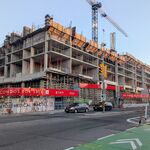Since 1974, air traffic through Toronto's Pearson International Airport has roughly doubled every twenty years. From the 10.5 million passengers recorded 42 years ago, to to over 41 million passengers last year, Toronto Pearson has grown to become Canada's leading aviation hub over the past three decades. The Greater Toronto Airports Authority (GTAA)—which manages the airport—is committed to furthering Pearson's development, with the goal of creating a global 'mega hub' by 2035.
Highlighting the diverse economic benefits of continued growth, a new GTAA report makes the case for increased connectivity, improved passenger experience, and a relaxed regulatory framework, to help spur the airport's ongoing expansion—and facilitate the positive economic spillovers associated with a global aviation hub.
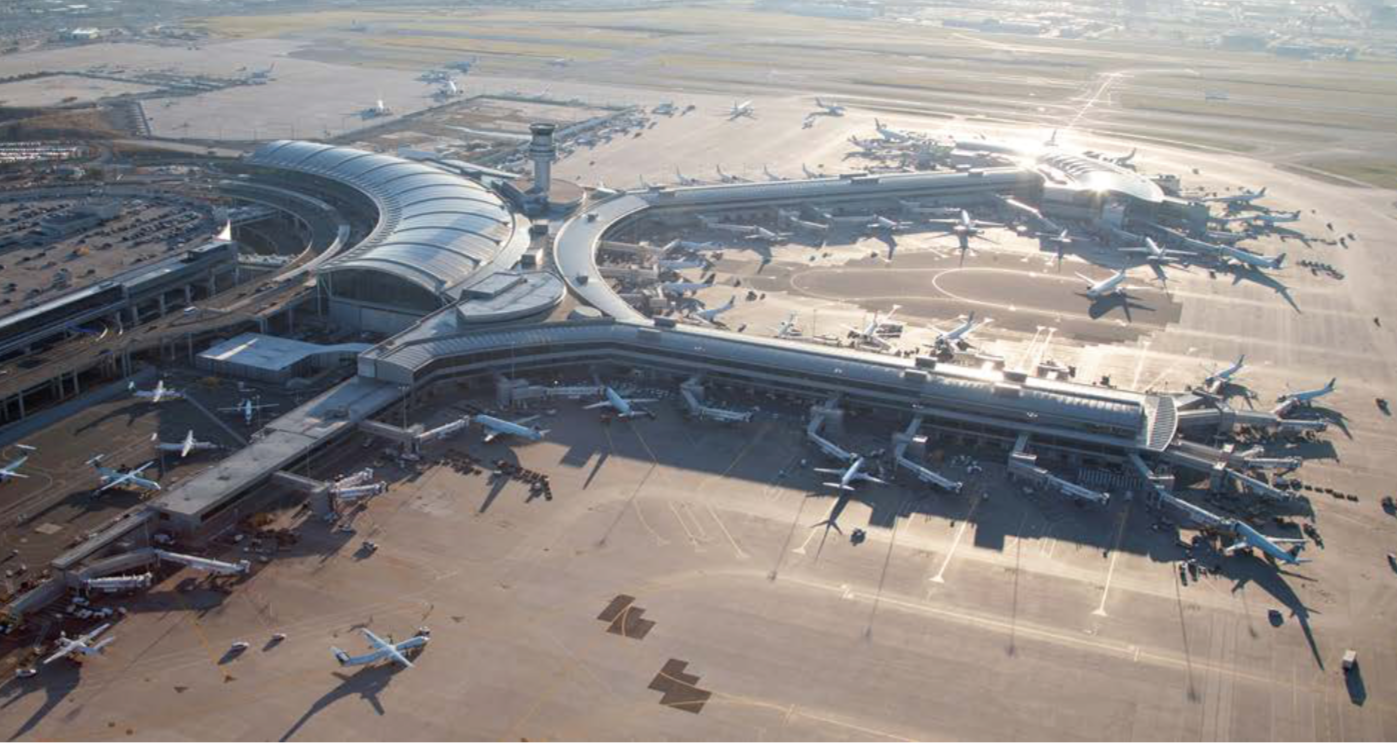 Pearson International Airport, image via GTAA report
Pearson International Airport, image via GTAA report
As outlined in the report, a mega hub is an airport that processes 50 million passengers a year, including at least 20 million international passengers, and connects to 80 per cent of the global economy. Pearson currently meets only one of these three criteria, with over 25 million international passengers recorded in 2015. It is roughly 9 million short of the 50 million passenger total, and 13% shy of global connectivity goals. While a record 44 million passengers are expected to pass through the airport in 2016, the GTAA stresses that significant investment and regulatory change is needed to help the airport reach its potential as an economic driver for the region.
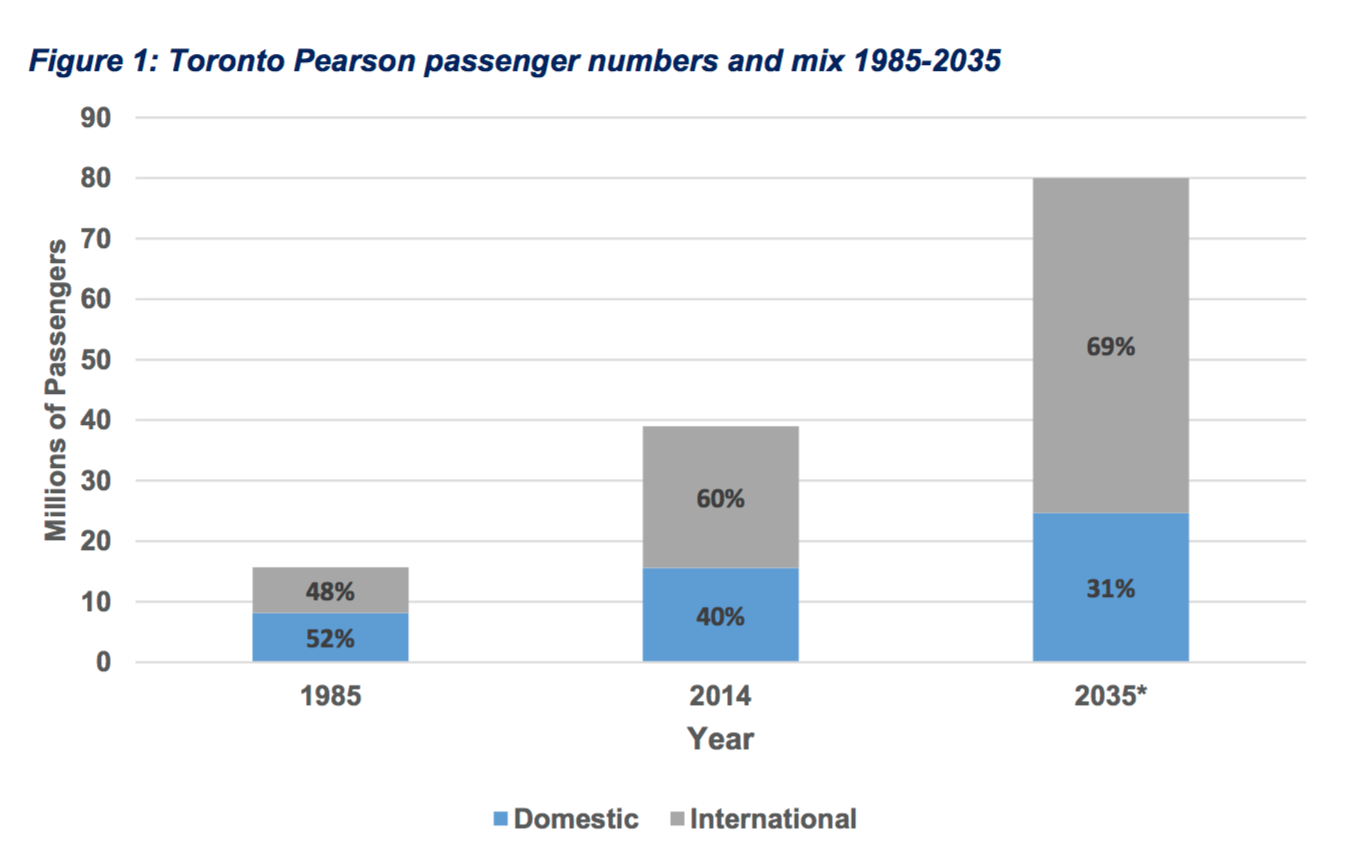 International passenger shares are consistently growing, image courtesy of GTAA
International passenger shares are consistently growing, image courtesy of GTAA
A mega hub, with a better connection to the world’s key economic markets, would contribute many benefits including job creation around the Airport Employment Zone, potentially boosting it from 332,000 now to over 700,000 jobs while increasing the area's contribution to Ontario’s Gross Domestic Product from 6.3% to 8.5%. As it stands, the airport is already a vital part of Canada's economy, with the surrounding region second only to Downtown Toronto as a national employment hub.
More broadly, the impact of airports as economic catalysts in the 21st century is arguably comparable to the impacts of highways, railroads, and seaports in the past three centuries respectively. According to the "aerotropolis model" of economic development by John Kasarda and Greg Lindsay, the vitality of the knowledge economy is strongly predicated on connectivity and accessibility of people. As urban theorist Richard Florida wrote in Citylab, "[a]irports play a substantial role on the economic growth and development of cities and regions. In today's knowledge economy, far and away, the most precious cargo they move is people."
***
The GTAA's formal push for a mega hub at Toronto Pearson began in September of 2015, when the agency partnered with Urban Strategies Inc. to publish a white paper called “Growth, Connectivity, Capacity—The Future of a Key Regional Asset.” The paper highlighted the need to expand the airport to support both the population growth around the Greater Toronto Area (GTA) and the Greater Golden Horseshoe (GGH), and as a key connection point for travellers around the world.
The two parties collaborated on a follow-up titled “Pearson Connects: A Multi-Modal Platform for Prosperity.” Published in February 2016, this report examined the lack of public transit options available to connect the roughly 332,000 employees working around the Airport Employment Zone and the passengers travelling in and out of the airport. Specifically, a look at the air passenger transit mode share—calculating the percentage of passengers using public transportation to access the airport—reveals Pearson's low public transportation engagement rate compared to other mega hubs around the world.
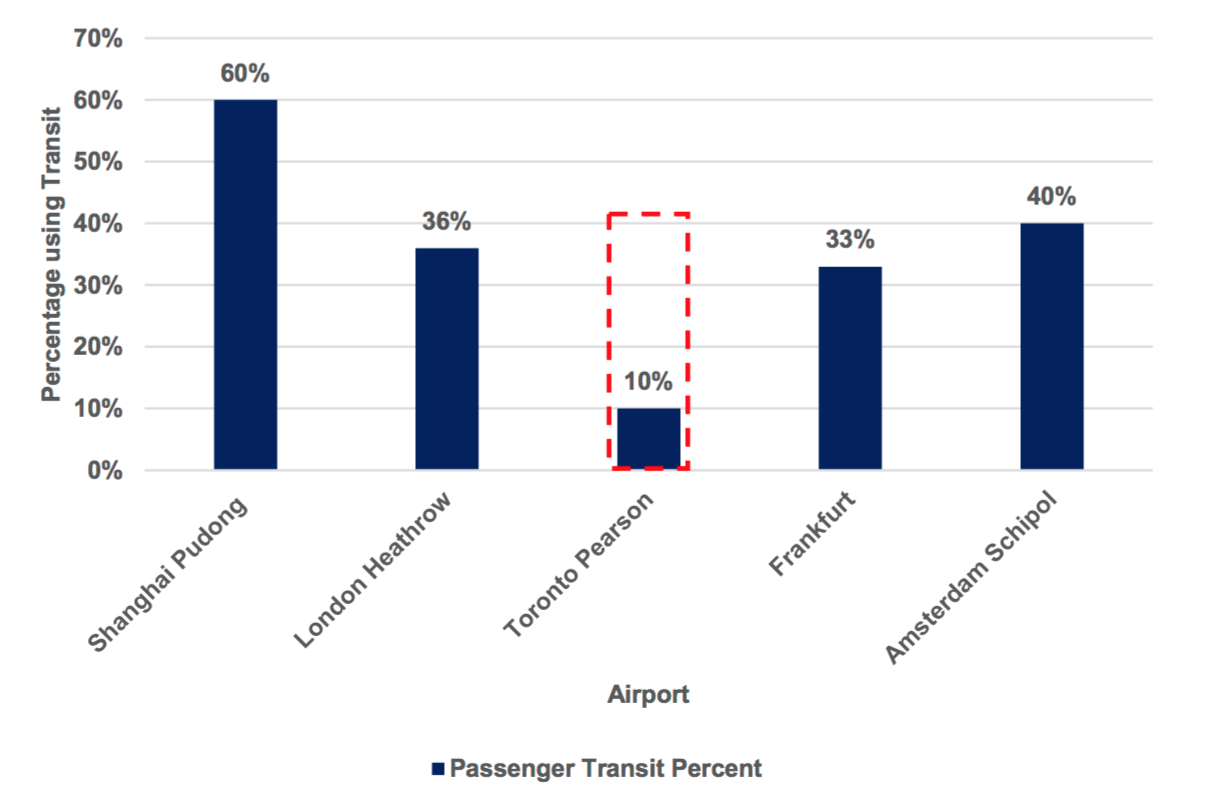 Comparing transit use with major global aviation hubs, image courtesy of GTAA
Comparing transit use with major global aviation hubs, image courtesy of GTAA
Further to the two papers, the GTAA's recently issued report adds to the series. Titled “Growing Canada with a Mega Hub Airport,” the report identifies three crucial challenges hindering the airport's potential. Released this month, the paper cites people movement, passenger experience, and regulatory restriction as key factors in shaping the airport's future.
People Movement
Public transportation access to Pearson has never exactly been a key selling point for the airport. Although the new Union-Pearson Express provides greater connectivity to Downtown Toronto, most passengers would require at least one connection and over 1.5 hours of travel time to access Toronto Pearson if they live within the city. Passengers around the GGH and the Waterloo/Kitchener area have no option but to transfer at Union Station even if GO or VIA Rail services pass near the airport currently.
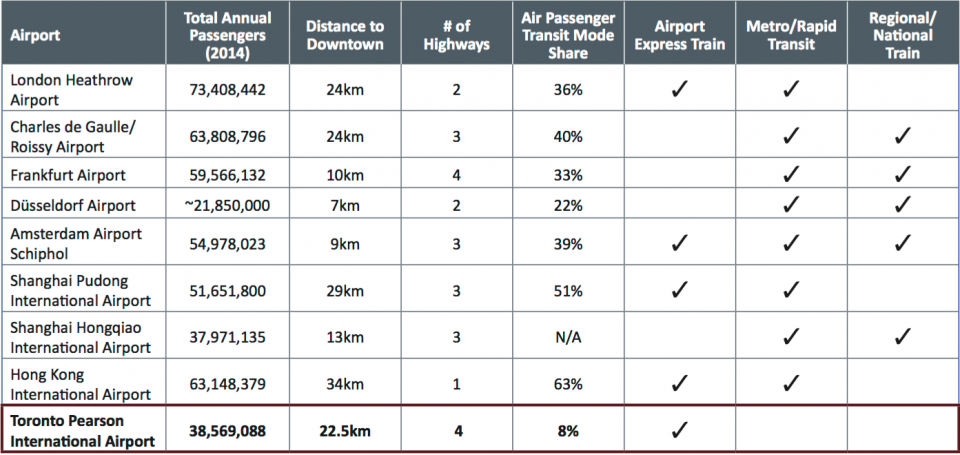 Comparing 2014 transit connectivity at Pearson (pre-UPX) to leading global airports, image via GTAA
Comparing 2014 transit connectivity at Pearson (pre-UPX) to leading global airports, image via GTAA
Meanwhile, over-reliance on cars as the dominant transportation mode to the airport will increase congestion on 400 series highways and nearby roads, indirectly hindering the region's productivity and revenue generation. The report calls for a coordinated effort between multiple levels of government, transit agencies and the GTAA, to construct and manage multi-modal options for all passengers heading to the airport within the next 20 years. At the 2016 Aviation Summit hosted by the Toronto Board of Trade in February 2016, Howard Eng, CEO and President of the GTAA, pitched the creation of a “Union Station West” hub that would be a multi-modal solution for passengers across the GTA and the GGH.
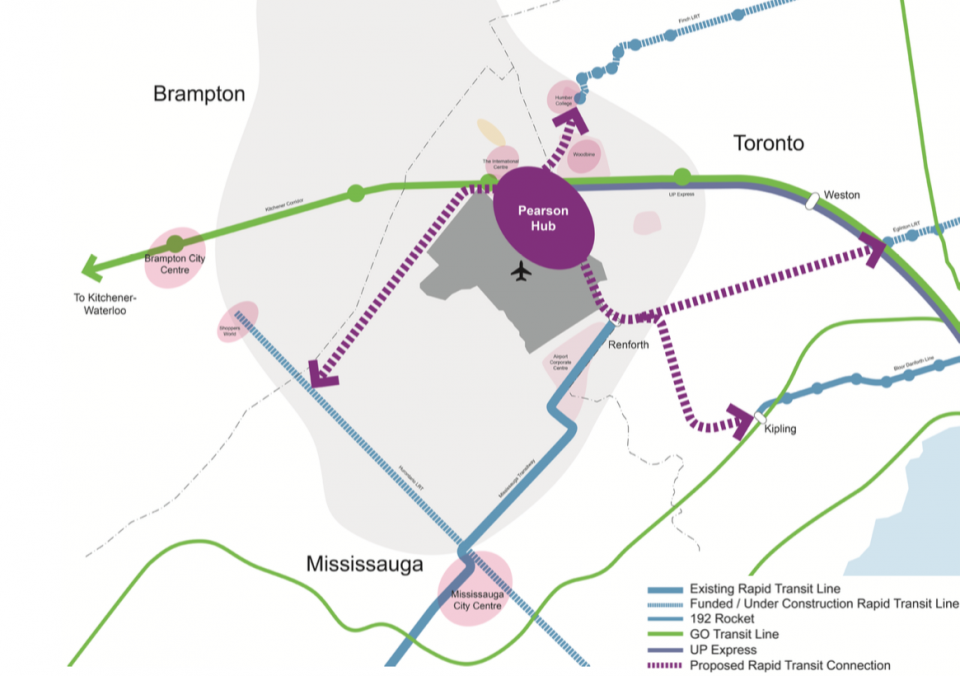 A map of the potential multi-modal hub at Pearson, image courtesy of the GTAA
A map of the potential multi-modal hub at Pearson, image courtesy of the GTAA
Passenger Experience
Toronto Pearson has a SkyTrax(R) customer satisfaction ranking outside of the top 40 for the past three years. Its current ranking of 44 is 30 places below that of the top Canadian airport Vancouver International Airport. The GTAA has been working for the past three years to improve overall passenger experience by renovating public spaces in terminals 1 and 3. Many passengers have complained about long processing time through security and border controls at peak times. As noted in the National Post, "[m]ost passengers at Pearson wait 20 minutes for pre-board screening compared to five minutes for 95 per cent of passengers at London’s Heathrow Airport and Hong Kong International Airport."
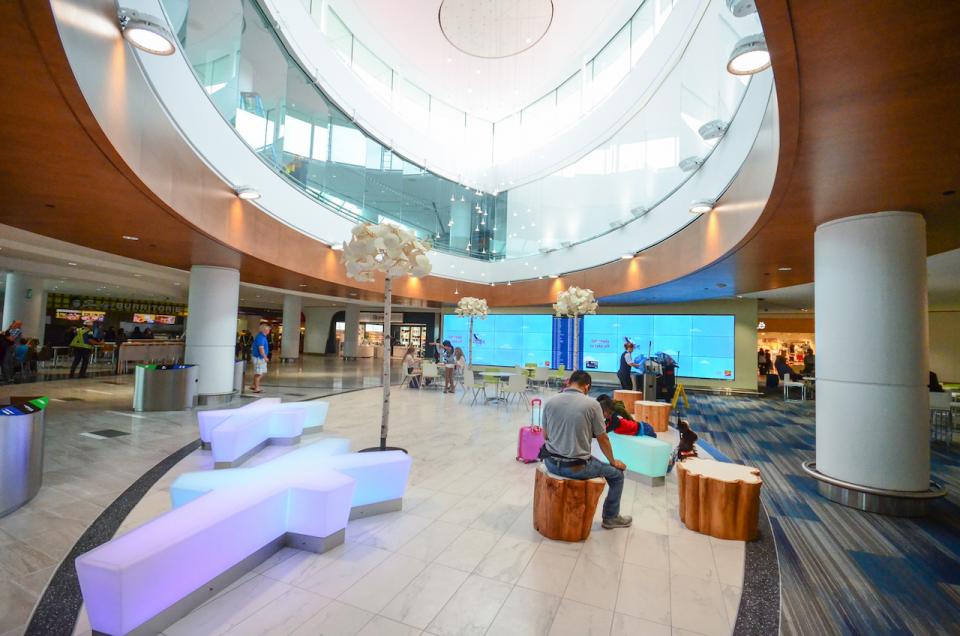 Newly enhanced spaces at Terminal 3 target an improved passenger experience, image courtesy of GTAA
Newly enhanced spaces at Terminal 3 target an improved passenger experience, image courtesy of GTAA
The GTAA would need additional Canadian Air Transport Security Authority (CATSA) and Canada Border Services Agency (CBSA) resources to standardize average processing time to levels comparable with other mega hub airports. Deployment of the new CATSA Plus screening systems being trialled at Montréal–Pierre Elliott Trudeau International Airport would be key to automate and reduce the screening time in general.
Regulatory Restrictions
There are different types of visa requirements (ranging from electronic travel documentation, to third party documentation, or no documentation) for international transit passengers. This creates confusion and deters some low risk passengers from using Toronto Pearson as a connection point, while also limiting non-aeronauctial revenue potential.
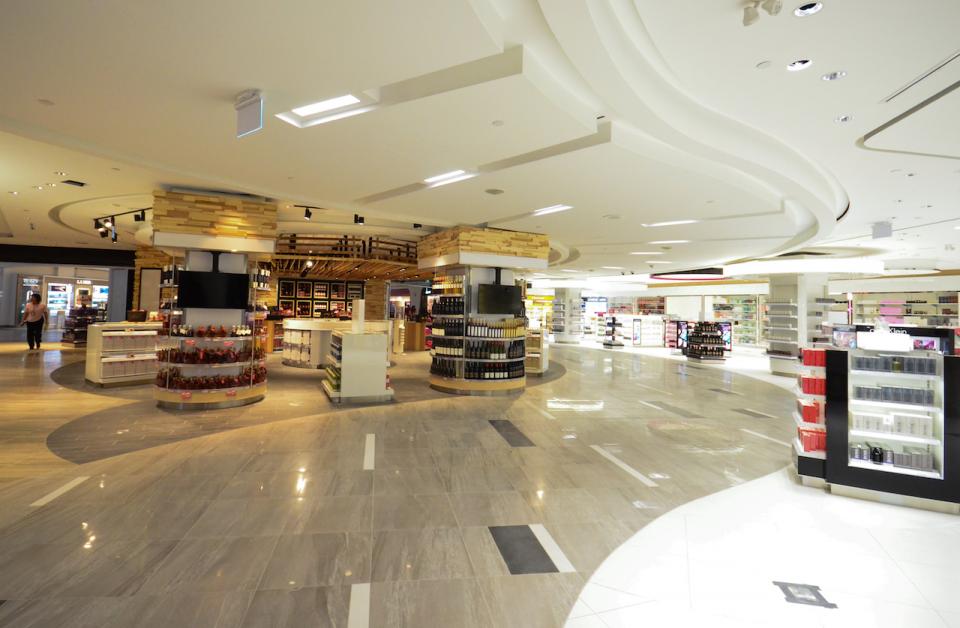 Enhanced Duty Free area in Terminal 3, image courtesy of the GTAA
Enhanced Duty Free area in Terminal 3, image courtesy of the GTAA
In recent years, non-aeronautical revenues from food service and retail outlets have come to play a bigger role at mega hubs. According to the GTAA, Toronto Pearson’s share of non-aeronautical revenue to total revenue is at 29.6%, compared with over 40% at mega hubs such as Hong Kong international Airport. This is in significant part attributable to the current federal government restriction placed on all Canadian airports in implementing Arrivals Duty Free (ADF) and Dual Duty Free Shops (DDFS). The first is the opportunity for international passengers to buy duty free products at the arrival hall, the latter to provide both domestic and international passengers access to duty free goods. Besides limiting shopping choices for all passengers, the GTAA estimates that the the loss of non-aeronautical revenue is about $127 million annually.
For these restrictions to change, Canada's Federal government would need to re-examine its visa requirement policies, and take steps to streamline application and enforcement for citizens of high risk countries. Additionally, the Federal government would need to work with the provinces in implementing ADF and DDFS, which could improve passenger experience while increasing revenue for Canada's airports.
More broadly, the high landing fees at Canadian airports arguably also pose a hindrance to passenger growth. With Pearson continually identified as "one of the most expensive airports in the world to land at," the existing fee structure may curtail the facility's economic competitiveness.
***
We will keep you updated as more information becomes available, and the push to create a global mega hub at Toronto's Pearson International Airport continues. In the meantime, a full copy of the report is available here, while an-depth conversation about the airport is ongoing in our Forum. Want to share your thoughts? Leave a comment on this page, or join the conversation in our Forum thread.

 3.7K
3.7K 
















